
Evapotranspiration Process And Methods Of Measuring
Understanding the various processes that drive plant growth is critical for successful farming. Evapotranspiration (ET) is one such process that has a major impact on agricultural productivity. Often overlooked, ET plays a pivotal role in maintaining soil moisture levels and sustaining plant health.
Modern technologies, in particular remote sensing and accurate hyperlocal weather data, allow farmers to minimize the time and effort previously required to calculate and continuously monitor the level of crop evapotranspiration, especially in large fields. We’ll go through what evapotranspiration is, define how it affects crop yields, and discuss the techniques for making it easier to calculate and factor into your irrigation plans.
What Is Evapotranspiration?
The term “evapotranspiration” refers to the total amount of water evaporating and transpiring from the Earth’s surface. Evaporation of water from the soil surface, the capillary fringe above the groundwater table, and surface water bodies are all components of ET. Transpiration, the process through which water moves from the soil through plants and into the air, is also part of the evapotranspiration system.
Rain is water that falls from the sky; ET is water that rises from the earth; thus, you can think of evapotranspiration as the opposite of rain. Clouds formed by the condensation of water vapor from evaporation and transpiration eventually release their load of precipitation as rain or snow. ET is second only to precipitation in terms of importance to water resource management and determining how much water should be applied to farms through irrigation.
Potential evapotranspiration refers to the capability to evaporate and transpire water from the surface when water is abundant. Actual evapotranspiration, on the other hand, refers to the amount of water lost from the surface owing to evaporation and transpiration. Both potential and actual ET can be used for agricultural applications.
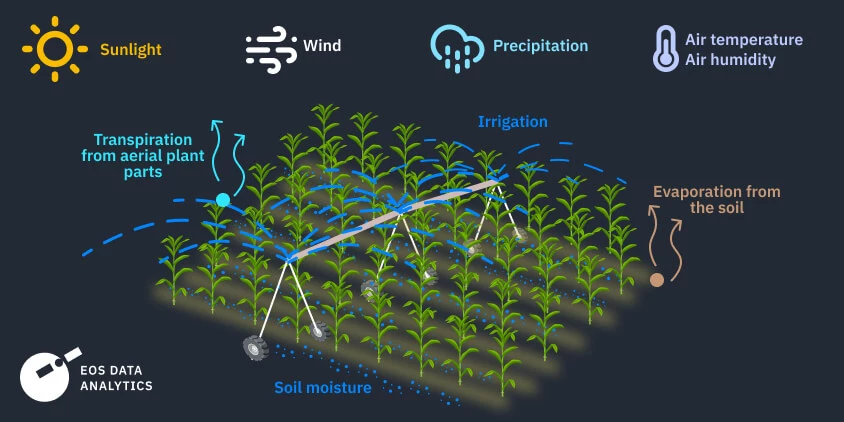
Process Of Evapotranspiration
Two components of the evapotranspiration process, evaporation and transpiration, are worth exploring in more detail. Evaporation is the transition of water from a liquid to a vaporous or gaseous state. Solar energy causes this effect on bodies of water as well as moist soil. When the water molecules absorb enough heat, they gain the energy necessary to leave the liquid’s surface and enter the air as vapor. This mechanism plays a crucial role in bringing moisture from the earth up into the atmosphere.
Transpiration, the release of water vapor into the atmosphere, is made possible by the microscopic pores (stomata) on the stems, leaves, and other aerial plant parts. During this part of the evapotranspiration process, the plant transports water from the ground through its root system to its aerial parts, where it evaporates. So, we may distinguish three distinct stages of transpiration:
- roots draw moisture up from the ground;
- water travels up through the plant, performing its vital functions along the way;
- stomata “exhales” moisture into the atmosphere.

Why Is Evapotranspiration So Important In Agriculture?
Farmers who take plant evapotranspiration into account may optimize water consumption and boost crop yields while contributing to global food security. Estimates of ET are crucial in the following areas of modern agricultural water management and cultivation:
- Optimizing irrigation. The use of evapotranspiration data to fine-tune irrigation scheduling helps avoid wasteful overwatering and protect precious water supplies. Farmers can cut down on their water use and energy bills by using precision irrigation based on ET rates.
- Boosting crop health and productivity. Keeping an eye on ET helps ensure appropriate soil moisture, which is necessary for healthy root growth and nutrient uptake as well as enhanced crop yields.
- Preparing for a drought. Since evapotranspiration frequently increases during droughts, with ET data at hand you can create more effective drought management programs and better allocate water resources in the event of dry spells.
- Water stress control. Monitoring ET readings, which open up the plants’ water needs, helps mitigate water stress and increase crop resilience.
- Raising the level of agricultural precision. By combining ET data with other information, farmers may tailor their field activities to the exact needs of each crop and soil type.
Without evapotranspiration, the water cycle would be ruptured. Understanding the role plants play in ET and the general water cycle is crucial, especially in arid regions where water conservation is of the utmost importance. Since plants cool the soil, having more of them might reduce evaporation. They also serve as windbreaks, keeping moist air closer to the ground. On the other hand, more plant cover may increase soil moisture loss through transpiration.
Factors That Affect Evapotranspiration
The main determinants of ET are the local climate and terrain, as well as the plant’s specific physiology. Let’s look at each one and its influence in more detail.
- Type of soil. The composition and structure of soil determine its ability to retain water and its evapotranspiration properties. Soils with a high proportion of sand or gravel have a lower capacity to hold water and will lose more of it to evaporation than, say, loamy or clay ones.
- Air temperature. The air temperature is a known factor in the evapotranspiration process. As the temperature rises, so does the air’s moisture-carrying capacity. Furthermore, increasing the amount of heat energy applied to water accelerates its vaporization, which raises the ET rate.
- Solar radiation. There is more to solar radiation than mere heat. Variations in energy, frequency, and albedo, all of which affect evapotranspiration rate, are site- and time-specific. These are important aspects to take into account, but quantifying them without technologically advanced methods and tools can be difficult.
- Humidity. Relative humidity (RH) is the amount of water vapor that the air can retain. High relative humidity (as seen, for instance, after rainfall) limits the amount of water vapor the air can absorb, resulting in a decrease in ET. Reduced humidity increases evapotranspiration because the air can potentially hold more moisture.
- Plant cover. Plants adapt to their environments in different ways. Some are better at storing water for use during droughts, while others lose moisture far more quickly. The evapotranspiration value also depends on the plant’s age and health conditions. The deeper the roots, the longer crops can survive without rain or watering. Because of physiological differences between different types of crops, ET rates vary a lot, calling for specific approaches to irrigation.
- Wind speed. Since wind is usually what propels both evaporation and transpiration, it plays a crucial role in soil moisture evapotranspiration. Strong winds blow away the layer of damp air that forms over crop-covered surfaces, increasing the ET rate. The wind’s effect on the diffusion of vapor from plant pores also contributes to increased transpiration rates. A decrease in ET may occur, though, if extremely strong, dry winds prevent water vapor from diffusion.

EOSDA Crop Monitoring
Fields analytics based on high-resolution satellite images to track all the changes on-the-spot!
Different Concepts Of Evapotranspiration
Crop evapotranspiration can be viewed in terms of three concepts:
- ET(0), or reference evapotranspiration;
- ET(c), or evapotranspiration in a typical setting;
- ET(c adj), or evapotranspiration in an atypical setting.
The atmospheric evapotranspiration power, denoted as ET(0), is a climate-related parameter. ET(c) describes the amount of water lost through evapotranspiration in well-maintained, massive, optimally moistened fields that produce at maximum capacity given the typical weather patterns. Since inefficient crop management and environmental limitations hinder evapotranspiration, it is common practice to adjust ET(c) under atypical conditions.
Reference Evapotranspiration
The rate of evapotranspiration that occurs at a water-rich reference surface is known as reference ET. A hypothetical grass cover that meets certain criteria serves as the reference surface.
Reference ET allows us to analyze atmospheric evaporative demand regardless of crop variety, growth stage, and cultivation practices. Since the reference surface used to calculate ET is well-moistened, soil conditions do not impact evapotranspiration. So it’s not necessary to determine a unique ET threshold for each crop at each growth stage.
Climate variables are the only factors determining ET(0). The following table provides the typical ET(0) value ranges for different agroclimatic zones . These numbers are meant to give a feel for what’s common but should not be used directly.
| Mean daily temperature | Cold: around 50°F (10°C), mm/day | Moderate: 68°F (20°C), mm/day | Warm: over 86°F (30°C), mm/day |
|---|---|---|---|
| Humid and sub-humid (tropics/subtropics) | 2-3 | 3-5 | 5-7 |
| Arid and semi-arid (tropics/subtropics) | 2-4 | 4-6 | 6-8 |
| Humid and sub-humid (temperature zone) | 1-2 | 2-4 | 4-7 |
| Arid and semi-arid (temperature zone) | 1-3 | 4-7 | 6-9 |
Evapotranspiration Under Standard Conditions
ET(c), or evapotranspiration under standard conditions, is the amount of water released into the atmosphere by a typical crop (one that is disease-free, well-fertilized, cultivated on vast fields with plenty of water, and yielding its maximum potential given the prevailing weather and temperature circumstances). ET(c) is calculated by multiplying the single crop coefficient – K(c) – by the reference evapotranspiration:
Evapotranspiration Under Non-Standard Conditions
As its name suggests, evapotranspiration under non-standard conditions – ET(c adj) – refers to the ET of crops grown under environmental and cultivation conditions that deviate from the norm. Under less-than-ideal conditions such as pest and disease infestation, lack or excess of water, increased soil salinity, and low soil fertility, the actual evapotranspiration of field crops can diverge from ET(c). To account for a variety of stresses and environmental impacts on crop evapotranspiration, ET(c adj) is calculated with the help of a water stress coefficient – K(s) – and/or a single crop coefficient:
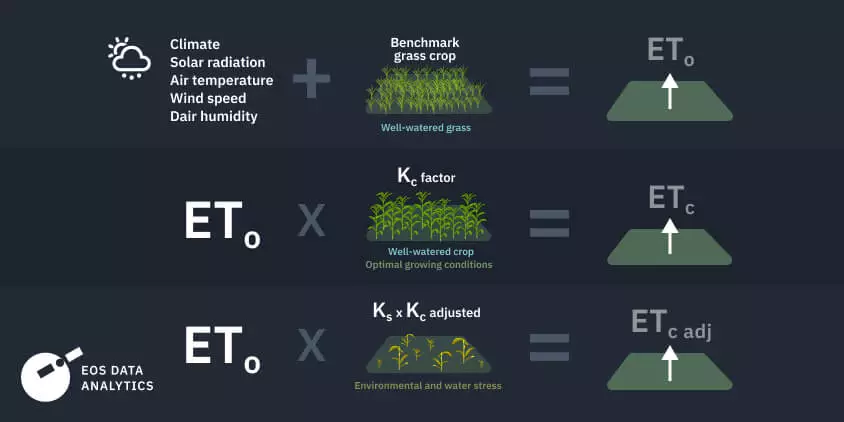
How To Measure Evapotranspiration
The standard unit of measurement for the evapotranspiration rate is millimeters (mm) per unit of time. It denotes the rate at which a given depth of water is lost from a crop-covered surface. Depending on your goals, the time unit can vary from as short as an hour to as long as an entire growing season.
There are a variety of ways to measure and calculate evapotranspiration. Every option comes with its own set of pros and cons, which we’ll now discuss.
Lysimeters
To get an accurate reading of actual ET, some farmers use lysimeters, which are underground soil containers with a weighing tool or drainage/vacuum system. The many challenges of modeling evapotranspiration can be sidestepped since there’s no need for interpretation or scaling of lysimeter readings.
Due to their high price and cumbersome operation, though, lysimeters are not without their drawbacks. These gauges are good for small fields or greenhouses. However, lysimeter manual measurements are expensive and time-consuming when applied to large plantations or for day-to-day evapotranspiration monitoring .
Atmometers
Typically, this instrument used to measure evapotranspiration consists of a container with water in it and an evaporation surface, such as a plate, that is open to the air. Water from the reservoir continuously refills the water evaporating from the plate. Agronomists calculate evaporation by measuring how much water from the container is lost to the atmosphere.
Water Balance
This evapotranspiration measurement method is commonly used for wide areas where streamflow and precipitation alone dictate the inflow and outflow and where the basin is cramped to rule out any other major inflow/outflow sources. The method can only provide a rough estimate of the average amount of water lost through evaporation and transpiration on crop-covered lands.
Eddy Covariance
Rather than measuring each part of the water balance individually, this technique relies on the energy balance instead. Because the eddy covariance sensors are installed above the canopy, ET can be estimated for many plant species without distortion from soil surface non-uniformity. The energy output from the ground surface, however, is known to be different from the energy input. Since balance closure is rarely achieved, the eddy covariance approach may underestimate evapotranspiration .
Remote Sensing
Evapotranspiration monitoring with remote sensing is gaining popularity among farmers. The analysis of satellite-derived weather, vegetation, and thermal infrared data helps them figure out how much water vapor is released from the field surface through evaporation and plant transpiration.
The normalized difference vegetation index (NDVI) is one such supplemental metric that can be used in estimating ET rates since there is a strong relation between evapotranspiration and NDVI. NDVI trends were shown to be most closely connected to patterns in potential ET for each unique combination of vegetation and soil. Likewise, cumulative NDVI was found to have a high correlation with cumulative actual ET for the entire growing season .
Meteo Data
Weather data allows farmers to keep a close eye on ET levels and make accurate forecasts about them. Rather than having to calculate the values themselves or invest in field gauges, farmers can take advantage of evapotranspiration weather stations, meteorological service providers’ turnkey solutions, and actionable ET indicators.
The high cost of the existing technologies makes it difficult for small farmers to accurately detect evapotranspiration in plants. The most cost-effective solution for them is portable atmometers because just a few devices are enough to cover a small field.
On the other hand, for large-scale farmers with expansive fields that may be located in different parts of the world, it is preferable to determine evapotranspiration using weather data. The following are some benefits of estimating evapotranspiration with the help of meteo data:
- no need to purchase, install, or maintain any ET gauges;
- field data is readily available from anywhere;
- meteorological data on ET, along with many other key indicators, can be accessed through user-friendly and intuitive agricultural platforms for farmers, such as EOSDA Crop Monitoring.
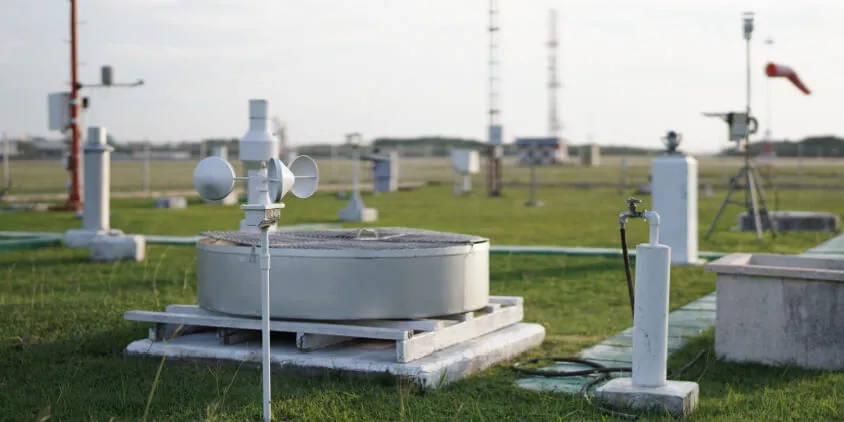
Ready-Made Evapotranspiration Measuring Solutions In EOSDA Crop Monitoring
The EOSDA Crop Monitoring platform integrates meteorological data with processed satellite imagery. Eliminating the need for expensive and time-consuming in-site equipment and intricate computations, our platform makes tracking the evapotranspiration values in your fields a breeze.
Data on ET and other meteorological indicators (such as precipitation, air temperature, and wind speed) are accessible in two formats: historical meteo data and weather forecasts. You can view daily ET reports and historical weather data spanning back to 1979. And the forecast will show you the projected evapotranspiration level in your field hour by hour for the following 14 days.
Our platform provides seamless accessibility to all data, allowing you to effortlessly view, download, or integrate it into your systems through our API. Don’t hesitate to reach out to our sales team at sales@eosda.com for further information and details.
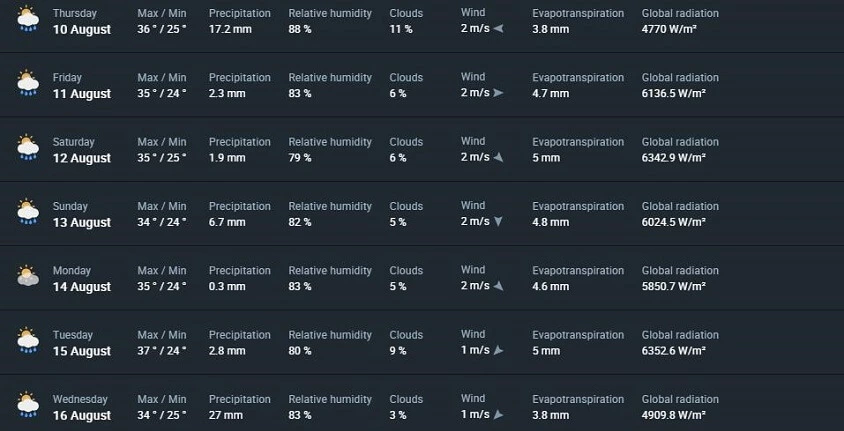
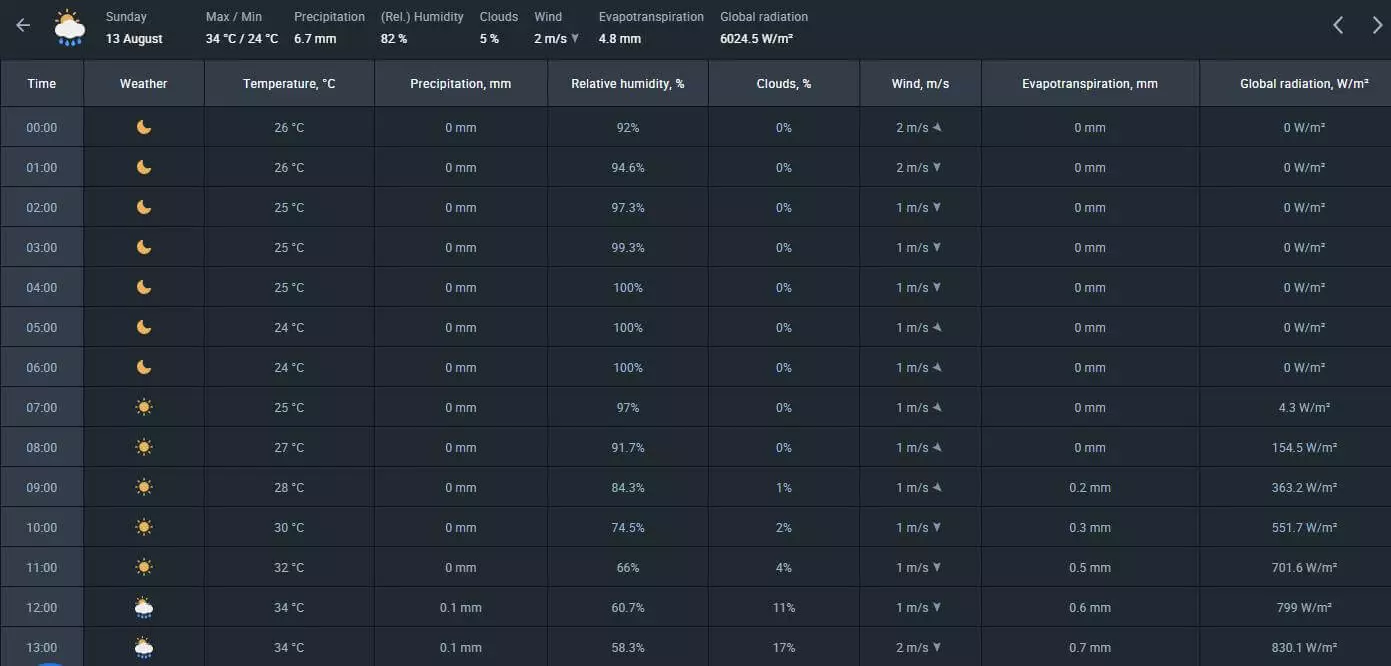
Evapotranspiration is a tricky yet critical metric to track in agriculture. While assessing and monitoring it may pose challenges to farmers, it is crucial to acknowledge the enormous impact it has on field planning, crop health, and ultimately yield. To aid in agricultural decision-making, EOSDA Crop Monitoring provides easy access to evapotranspiration data in a convenient format.
Through the EOSDA Crop Monitoring platform, you may not only keep an eye on evapotranspiration but also receive a wealth of other helpful agro data such as vegetation indices and soil moisture levels, as well as beneficial farm management tools including the Scouting app and Field activity log. With this much insight at your fingertips, you’ll be able to run your farm more efficiently and effectively, bringing about better crop yields at lower costs.
About the author:
Vasyl Cherlinka is a Doctor of Biosciences specializing in pedology (soil science), with 30 years of experience in the field. He attended the engineering college in Ukraine and received his degree in agrochemistry, agronomy and soil science in the Chernivtsi National University. Since 2018, Dr. Cherlinka has been advising EOSDA on problems in soil science, agronomy, and agrochemistry.
Recent articles

Analyze 2025 & Plan Your Best Year Yet: LandViewer Christmas Offer
It’s the most wonderful time of the year! The Christmas holidays are here, and so is your chance to analyze 2025 and plan a prosperous 2026 with more affordable Pro plans in LandViewer.

EOSDA Models Climate Change Impact On Sugarcane Yields
EOSDA modeled future temperature, rainfall, and other climate impacts on Veracruz sugarcane. The results help growers plan long-term adaptation strategies, including timing, varieties, and irrigation.

EOSDA LandViewer Black Friday Sale: Exclusive Offers & Giveaway
This Black Friday, LandViewer offers new users the chance to save on monthly plans, get extra months with yearly subscriptions, and participate in a free annual plan giveaway.